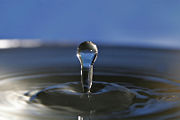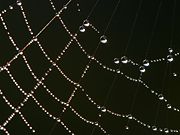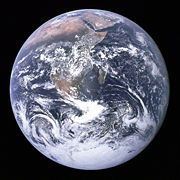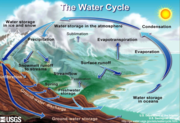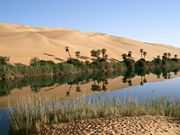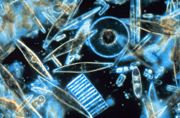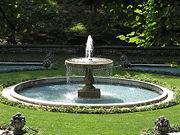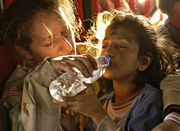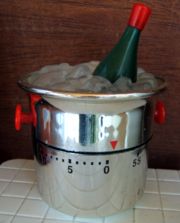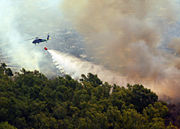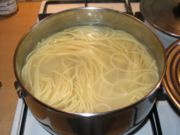Water
2008/9 Schools Wikipedia Selection. Related subjects: Climate and the Weather

Water is a common chemical substance that is essential for the survival of all known forms of life. In typical usage, water refers only to its liquid form or state, but the substance also has a solid state, ice, and a gaseous state, water vapor. About 1.460 petatonnes (Pt) of water covers 71% of the Earth's surface, mostly in oceans and other large water bodies, with 1.6% of water below ground in aquifers and 0.001% in the air as vapor, clouds (formed of solid and liquid water particles suspended in air), and precipitation. Saltwater oceans hold 97% of surface water, glaciers and polar ice caps 2.4%, and other land surface water such as rivers, lakes and ponds 0.6%. Some of the Earth's water is contained within water towers, biological bodies, manufactured products, and food stores. Other water is trapped in ice caps, glaciers, aquifers, or in lakes, sometimes providing fresh water for life on land.
Water moves continually through a cycle of evaporation or transpiration ( evapotranspiration), precipitation, and runoff, usually reaching the sea. Winds carry water vapor over land at the same rate as runoff into the sea, about 36 Tt per year. Over land, evaporation and transpiration contribute another 71 Tt per year to the precipitation of 107 Tt per year over land. Clean, fresh drinking water is essential to human and other life. However, in many parts of the world - especially developing countries - there is a water crisis, and it is estimated that by 2025 more than half of the world population will be facing water-based vulnerability. Water plays an important role in the world economy, as it functions as a solvent for a wide variety of chemical substances and facilitates industrial cooling and transportation. Approximately 70% of freshwater is consumed by agriculture.
Types of water
Water can appear in three phases. Water takes many different forms on Earth: water vapor and clouds in the sky; seawater and rarely icebergs in the ocean; glaciers and rivers in the mountains; and aquifers in the ground.
Water can dissolve many different substances, giving it different tastes and odours. In fact, humans and other animals have developed senses to be able to evaluate the potability of water: animals generally dislike the taste of salty sea water and the putrid swamps and favour the purer water of a mountain spring or aquifer. Humans also tend to prefer cold water rather than lukewarm, as cold water is likely to contain fewer microbes. The taste advertised in spring water or mineral water derives from the minerals dissolved in it, as pure H2O is tasteless. As such, purity in spring and mineral water refers to purity from toxins, pollutants, and microbes.
Different names are given to water's various forms:
- according to phase
- solid - ice
- liquid - water
- gaseous - water vapor
- according to meteorology:
- hydrometeor
- precipitation
- hydrometeor
-
precipitation according to moves precipitation according to phase
-
- levitating particles
- clouds
- fog
- BR (according to METAR)
- ascending particles (drifted by wind)
- spindrift
- stirred snow
- levitating particles
- according to occurrence
- groundwater
- meltwater
- meteoric water
- connate water
- fresh water
- mineral water – contains much minerals
- brackish water
- dead water – strange phenomenon which can occur when a layer of fresh or brackish water rests on top of more dense salt water, without the two layers mixing. It is dangerous for ship traveling.
- seawater
- brine
- according to uses
- tap water
- bottled water
- drinking water or potable water – useful for everyday drinking, without fouling, it contains balanced minerals that are not harmful to health (see below)
- purified water, laboratory-grade, analytical-grade or reagent-grade water – water which has been highly purified for specific uses in science or engineering. Often broadly classified as Type I, Type II, or Type III, this category of water includes, but is not limited to the following:
- distilled water
- double distilled water
- deionized water
- according to other features
- soft water – contains less minerals
- hard water – from underground, contains more minerals
- distilled water, double distilled water, deionized water - contains no minerals
- heavy water – made from heavy atoms of hydrogen - deuterium. It is in nature in normal water in very low concentration. It was used in construction of first nuclear reactors.
- tritiated water
- according to microbiology
- drinking water
- wastewater
- stormwater or surface water
- according to religion
- holy water
Chemical and physical properties
| Water | |
|---|---|
 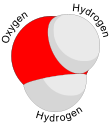 Water is a necessary solvent for all known life, and |
|
| Information and properties | |
| Common name | water |
| IUPAC name | oxidane |
| Alternative names | aqua, dihydrogen monoxide, hydrogen hydroxide, ( more) |
| Molecular formula | H2O |
| CAS number | 7732-18-5 |
| InChI | InChI=1/H2O/h1H2 |
| Molar mass | 18.0153 g/mol |
| Density and phase | 0.998 g/cm³ (liquid at 20 °C, 1 atm) 0.917 g/cm³ (solid at 0 °C, 1 atm) |
| Melting point | 0 °C (273.15 K) (32 °F) |
| Boiling point | 99.974 °C (373.124 K) (211.95 °F) |
| Specific heat capacity | 4.184 J/(g·K) (liquid at 20 °C) |
| Supplementary data page | |
| Disclaimer and references | |
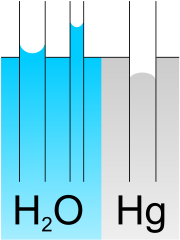
Water is the chemical substance with chemical formula H2O: one molecule of water has two hydrogen atoms covalently bonded to a single oxygen atom.
The major chemical and physical properties of water are:
- Water is a tasteless, odorless liquid at ambient temperature and pressure. The colour of water and ice are, intrinsically, a very light blue hue, although water appears colorless in small quantities. Ice also appears colorless, and water vapor is essentially invisible as a gas.
- Water is transparent, and thus aquatic plants can live within the water because sunlight can reach them. Only strong UV light is slightly absorbed.
- Water is a liquid under standard conditions.
- Since oxygen has a higher electronegativity than hydrogen, water is a polar molecule. The oxygen has a slight negative charge while the hydrogens have a slight positive charge giving the article a strong effective dipole moment. The interactions between the different dipoles of each molecule cause a net attraction force associated with water's high amount of surface tension.
- Another very important force that causes the water molecules to stick to one another is the hydrogen bond.
- The boiling point of water (and all other liquids) is directly related to the barometric pressure. For example, on the top of Mt. Everest water boils at about 68 °C (154 °F), compared to 100 °C (212 °F) at sea level. Conversely, water deep in the ocean near geothermal vents can reach temperatures of hundreds of degrees and remain liquid.
- Water sticks to itself. Water has a high surface tension caused by the strong cohesion between water molecules because it is polar. The apparent elasticity caused by surface tension drives the capillary waves.
- Water also has high adhesion properties because of its polar nature.
- Capillary action refers to the tendency of water to move up a narrow tube against the force of gravity. This property is relied upon by all vascular plants, such as trees.
- Water is a very strong solvent, referred to as the universal solvent, dissolving many types of substances. Substances that will mix well and dissolve in water, e.g. salts, sugars, acids, alkalis, and some gases: especially oxygen, carbon dioxide ( carbonation), are known as " hydrophilic" (water-loving) substances, while those that do not mix well with water (e.g. fats and oils), are known as " hydrophobic" (water-fearing) substances.
- Pure water has a low electrical conductivity, but this increases significantly upon solvation of a small amount of ionic material such as sodium chloride.
- Water has the second highest specific heat capacity of any known chemical compound, after ammonia, as well as a high heat of vaporization (40.65 kJ mol−1), both of which are a result of the extensive hydrogen bonding between its molecules. These two unusual properties allow water to moderate Earth's climate by buffering large fluctuations in temperature.
- The maximum density of water is at 3.98 °C (39.16 °F). Water becomes even less dense upon freezing, expanding 9%. This causes an unusual phenomenon: ice floats upon water, and so water organisms can live inside a partly frozen pond because the water on the bottom has a temperature of around 4 °C (39 °F).
- Water is miscible with many liquids, for example ethanol, in all proportions, forming a single homogeneous liquid. On the other hand, water and most oils are immiscible usually forming layers according to increasing density from the top. As a gas, water vapor is completely miscible with air.
- Water forms an azeotrope with many other solvents.
- Some substances (sodium, lithium, calcium, potassium) emit a flammable gas (hydrogen) when wet, or react violently with water.
Distribution of water in nature
Water in the Universe
Much of the universe's water may be produced as a byproduct of star formation. When stars are born, their birth is accompanied by a strong outward wind of gas and dust. When this outflow of material eventually impacts the surrounding gas, the shock waves that are created compress and heat the gas. The water observed is quickly produced in this warm dense gas.
Water has been detected in interstellar clouds within our galaxy, the Milky Way. It is believed that water exists in abundance in other galaxies too, because its components, hydrogen and oxygen, are among the most abundant elements in the universe. Interstellar clouds eventually condense into solar nebulae and solar systems, such as ours.
Water vapor is present on:
- Mercury - 3.4% in the atmosphere, a large amounts of water in Mercury's exosphere
- Venus - 0.002% in the atmosphere
- Earth - trace in the atmosphere (varies with climate)
- Mars - 0.03% in the atmosphere
- Jupiter - 0.0004% in the atmosphere
- Saturn - in ices only
- Enceladus (moon of Saturn) - 91% in the atmosphere
- exoplanets known as HD 189733 b and HD 209458 b.
Liquid water is present on:
- Earth - 71% of surface
- Moon - small amounts of water have been found (in 2008) in the inside of volcanic pearls brought from Moon to Earth by the Apollo 15 crew in 1971.
Strong evidence suggests that liquid water is present just under the surface of Saturn's moon Enceladus. Probably some liquid water is on Europa.
Water ice is present on:
- Earth - mainly on ice sheets
- polar ice caps on Mars
- Titan
- Europa
- Enceladus
Probability or possibility of distribution of water ice is at: lunar ice on the Moon, Ceres (dwarf planet), Tethys (moon). Ice is probably in internal structure of Uranus, Neptune, and Pluto and on comets.
Water and habitable zone
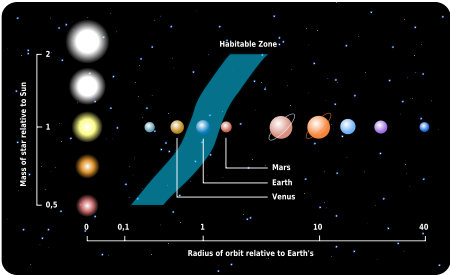
The existence of liquid water, and to a lesser extent its gaseous and solid forms, on Earth is vital to the existence of life on Earth as we know it. The Earth is located in the habitable zone of the solar system; if it were slightly closer to or further from the Sun (about 5%, or 8 million kilometres or so), the conditions which allow the three forms to be present simultaneously would be far less likely to exist.
Earth's mass allows gravity to hold an atmosphere. Water vapor and carbon dioxide in the atmosphere provide a greenhouse effect which helps maintain a relatively steady surface temperature. If Earth were smaller, a thinner atmosphere would cause temperature extremes preventing the accumulation of water except in polar ice caps (as on Mars).
It has been proposed that life itself may maintain the conditions that have allowed its continued existence. The surface temperature of Earth has been relatively constant through geologic time despite varying levels of incoming solar radiation ( insolation), indicating that a dynamic process governs Earth's temperature via a combination of greenhouse gases and surface or atmospheric albedo. This proposal is known as the Gaia hypothesis.
The state of water also depends on a planet's gravity. If a planet is sufficiently massive, the water on it may be solid even at high temperatures, because of the high pressure caused by gravity.
There are various theories about origin of water on Earth.
Water on Earth
Hydrology is the study of the movement, distribution, and quality of water throughout the Earth. The study of the distribution of water is hydrography. The study of the distribution and movement of groundwater is hydrogeology, of glaciers is glaciology, of inland waters is limnology and distribution of oceans is oceanography. Ecological processes with hydrology are in focus of ecohydrology.
The collective mass of water found on, under, and over the surface of a planet is called hydrosphere. Earth's approximate water volume (the total water supply of the world) is 1 360 000 000 km³ (326 000 000 mi³). Of this volume:
- 1 320 000 000 km³ (316 900 000 mi³ or 97.2%) is in the oceans.
- 25 000 000 km³ (6 000 000 mi³ or 1.8%) is in glaciers, ice caps and ice sheets.
- 13 000 000 km³ (3,000,000 mi³ or 0.9%) is groundwater.
- 250 000 km³ (60,000 mi³ or 0.02%) is fresh water in lakes, inland seas, and rivers.
- 13 000 km³ (3,100 mi³ or 0.001%) is atmospheric water vapor at any given time.
Groundwater and fresh water are useful or potentially useful to humans as water resources.
Liquid water is found in bodies of water, such as an ocean, sea, lake, river, stream, canal, pond, or puddle. The majority of water on Earth is sea water. Water is also present in the atmosphere in solid, liquid, and vapor phases. It also exists as groundwater in aquifers.
The most important geological processes caused by water are: chemical weathering, water erosion, water sediment transport and sedimentation, mudflows, ice erosion and sedimentation by glacier.
Water cycle
The water cycle (known scientifically as the hydrologic cycle) refers to the continuous exchange of water within the hydrosphere, between the atmosphere, soil water, surface water, groundwater, and plants.
Water moves perpetually through each of these regions in the water cycle consisting of following transfer processes:
- evaporation from oceans and other water bodies into the air and transpiration from land plants and animals into air.
- precipitation, from water vapor condensing from the air and falling to earth or ocean.
- runoff from the land usually reaching the sea.
Most water vapor over the oceans returns to the oceans, but winds carry water vapor over land at the same rate as runoff into the sea, about 36 Tt per year. Over land, evaporation and transpiration contribute another 71 Tt per year. Precipitation, at a rate of 107 Tt per year over land, has several forms: most commonly rain, snow, and hail, with some contribution from fog and dew. Condensed water in the air may also refract sunlight to produce rainbows.
Water runoff often collects over watersheds flowing into rivers. A mathematical model used to simulate river or stream flow and calculate water quality parameters is hydrological transport model. Some of water is diverted to irrigation for agriculture. Rivers and seas offer opportunity for travel and commerce. Through erosion, runoff shapes the environment creating river valleys and deltas which provide rich soil and level ground for the establishment of population centers. A flood occurs when an area of land, usually low-lying, is covered with water. It is when a river overflows its banks or flood from the sea. A drought is an extended period of months or years when a region notes a deficiency in its water supply. This occurs when a region receives consistently below average precipitation.
Fresh water storage
Some runoff water is trapped for periods, for example in lakes. At high altitude, during winter, and in the far north and south, snow collects in ice caps, snow pack and glaciers. Water also infiltrates the ground and goes into aquifers. This groundwater later flows back to the surface in springs, or more spectacularly in hot springs and geysers. Groundwater is also extracted artificially in wells. This water storage is important, since clean, fresh water is essential to human and other land-based life. In many parts of the world, it is in short supply.
Tides
Tides are the cyclic rising and falling of Earth's ocean surface caused by the tidal forces of the Moon and the Sun acting on the oceans. Tides cause changes in the depth of the marine and estuarine water bodies and produce oscillating currents known as tidal streams. The changing tide produced at a given location is the result of the changing positions of the Moon and Sun relative to the Earth coupled with the effects of Earth rotation and the local bathymetry. The strip of seashore that is submerged at high tide and exposed at low tide, the intertidal zone, is an important ecological product of ocean tides.
Effects on life
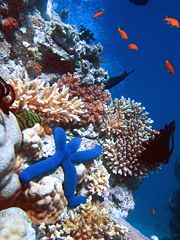
From a biological standpoint, water has many distinct properties that are critical for the proliferation of life that set it apart from other substances. It carries out this role by allowing organic compounds to react in ways that ultimately allow replication. All known forms of life depend on water. Water is vital both as a solvent in which many of the body's solutes dissolve and as an essential part of many metabolic processes within the body. Metabolism is the sum total of anabolism and catabolism. In anabolism, water is removed from molecules (through energy requiring enzymatic chemical reactions) in order to grow larger molecules (e.g. starches, triglycerides and proteins for storage of fuels and information). In catabolism, water is used to break bonds in order to generate smaller molecules (e.g. glucose, fatty acids and amino acids to be used for fuels for energy use or other purposes). Water is thus essential and central to these metabolic processes. Therefore, without water, these metabolic processes would cease to exist, leaving us to muse about what processes would be in its place, such as gas absorption, dust collection, etc.
Water is also central to photosynthesis and respiration. Photosynthetic cells use the sun's energy to split off water's hydrogen from oxygen. Hydrogen is combined with CO2 (absorbed from air or water) to form glucose and release oxygen. All living cells use such fuels and oxidize the hydrogen and carbon to capture the sun's energy and reform water and CO2 in the process (cellular respiration).
Water is also central to acid-base neutrality and enzyme function. An acid, a hydrogen ion (H+, that is, a proton) donor, can be neutralized by a base, a proton acceptor such as hydroxide ion (OH−) to form water. Water is considered to be neutral, with a pH (the negative log of the hydrogen ion concentration) of 7. Acids have pH values less than 7 while bases have values greater than 7. Stomach acid (HCl) is useful to digestion. However, its corrosive effect on the esophagus during reflux can temporarily be neutralized by ingestion of a base such as aluminium hydroxide to produce the neutral molecules water and the salt aluminium chloride. Human biochemistry that involves enzymes usually performs optimally around a biologically neutral pH of 7.4.
For example a cell of Escherichia coli contains 70% of water, a human body 60-70%, plant body up to 90% and the body of an adult jellyfish is made up of 94–98% water.
Aquatic life forms
Earth's waters are filled with life. The earliest life forms appeared in water; nearly all fish live exclusively in water, and there are many types of marine mammals, such as dolphins and whales that also live in the water. Some kinds of animals, such as amphibians, spend portions of their lives in water and portions on land. Plants such as kelp and algae grow in the water and are the basis for some underwater ecosystems. Plankton is generally the foundation of the ocean food chain.
Aquatic animals must obtain oxygen to survive, and they do so in various ways. Fish have gills instead of lungs, although some species of fish, such as the lungfish, have both. Marine mammals, such as dolphins, whales, otters, and seals need to surface periodically to breathe air. Smaller life forms are able to absorb oxygen through their skin.
Effects on human civilization
Civilization has historically flourished around rivers and major waterways; Mesopotamia, the so-called cradle of civilization, was situated between the major rivers Tigris and Euphrates; the ancient society of the Egyptians depended entirely upon the Nile. Large metropolises like Rotterdam, London, Montreal, Paris, New York City, Shanghai, Tokyo, Chicago, and Hong Kong owe their success in part to their easy accessibility via water and the resultant expansion of trade. Islands with safe water ports, like Singapore, have flourished for the same reason. In places such as North Africa and the Middle East, where water is more scarce, access to clean drinking water was and is a major factor in human development.
Health and pollution
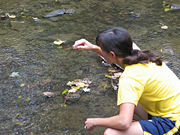
Water fit for human consumption is called drinking water or potable water. Water that is not potable can be made potable by filtration or distillation (heating it until it becomes water vapor, and then capturing the vapor without any of the impurities it leaves behind), or by other methods (chemical or heat treatment that kills bacteria). Sometimes the term safe water is applied to potable water of a lower quality threshold (i.e., it is used effectively for nutrition in humans that have weak access to water cleaning processes, and does more good than harm). Water that is not fit for drinking but is not harmful for humans when used for swimming or bathing is called by various names other than potable or drinking water, and is sometimes called safe water, or "safe for bathing". Chlorine is a skin and mucous membrane irritant that is used to make water safe for bathing or drinking. Its use is highly technical and is usually monitored by government regulations (typically 1 part per million (ppm) for drinking water, and 1-2 ppm of chlorine not yet reacted with impurities for bathing water).
This natural resource is becoming scarcer in certain places, and its availability is a major social and economic concern. Currently, about 1 billion people around the world routinely drink unhealthy water. Most countries accepted the goal of halving by 2015 the number of people worldwide who do not have access to safe water and sanitation during the 2003 G8 Evian summit. Even if this difficult goal is met, it will still leave more than an estimated half a billion people without access to safe drinking water and over 1 billion without access to adequate sanitation. Poor water quality and bad sanitation are deadly; some 5 million deaths a year are caused by polluted drinking water. Water, however, is not a finite resource, but rather re-circulated as potable water in precipitation in quantities many degrees of magnitude higher than human consumption. Therefore, it is the relatively small quantity of water in reserve in the earth (about 1% of our drinking water supply, which is replenished in aquifers around every 1 to 10 years), that is a non-renewable resource, and it is, rather, the distribution of potable and irrigation water which is scarce, rather than the actual amount of it that exists on the earth. Water-poor countries use importation of goods as the primary method of importing water (to leave enough for local human consumption), since the manufacturing process uses around 10 to 100 times products' masses in water.
In the developing world, 90% of all wastewater still goes untreated into local rivers and streams. Some 50 countries, with roughly a third of the world’s population, also suffer from medium or high water stress, and 17 of these extract more water annually than is recharged through their natural water cycles. The strain not only affects surface freshwater bodies like rivers and lakes, but it also degrades groundwater resources.
Human uses
Agriculture
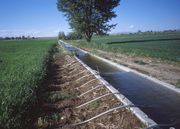
The most important use of water in agriculture is for an irrigation and irrigation is key component to produce enough food. Irrigation takes up to 90% of water withdrawn in some developing countries.
As a scientific standard
On 7 April 1795, the gram was defined in France to be equal to "the absolute weight of a volume of pure water equal to a cube of one hundredth of a meter, and to the temperature of the melting ice." For practical purposes though, a metallic reference standard was required, one thousand times more massive, the kilogram. Work was therefore commissioned to determine precisely how massive one liter of water was. In spite of the fact that the decreed definition of the gram specified water at 0 °C—a highly stable temperature point—the scientists chose to redefine the standard and to perform their measurements at the most stable density point: the temperature at which water reaches maximum density, which was measured at the time as 4 °C.
The Kelvin temperature scale of the SI system is based on the triple point of water, defined as exactly 273.16 K or 0.01 °C. The scale is a more accurate development of the Celsius temperature scale, which is defined by the boiling point (100 °C) and melting point (0 °C) of water.
Natural water consists mainly of the isotopes hydrogen-1 and oxygen-16, but there is also small quantity of heavier isotopes such as hydrogen-2 ( deuterium). The amount of deuterium oxides or heavy water is very small, but it still affects the properties of water. Water from rivers and lakes tends to contain less deuterium than seawater. Therefore, a standard water called Vienna Standard Mean Ocean Water is defined as the standard water.
For drinking
The human body is anywhere from 55% to 78% water depending on body size. To function properly, the body requires between one and seven liters of water per day to avoid dehydration; the precise amount depends on the level of activity, temperature, humidity, and other factors. Most of this is ingested through foods or beverages other than drinking straight water. It is not clear how much water intake is needed by healthy people, though most advocates agree that 6–7 glasses of water (approximately 2 litres) daily is the minimum to maintain proper hydration. Medical literature favors a lower consumption, typically 1 liter of water for an average male, excluding extra requirements due to fluid loss from exercise or warm weather. For those who have healthy kidneys, it is rather difficult to drink too much water, but (especially in warm humid weather and while exercising) it is dangerous to drink too little. People can drink far more water than necessary while exercising, however, putting them at risk of water intoxication (hyperhydration), which can be fatal. The "fact" that a person should consume eight glasses of water per day cannot be traced back to a scientific source. There are other myths such as the effect of water on weight loss and constipation that have been dispelled.
An original recommendation for water intake in 1945 by the Food and Nutrition Board of the National Research Council read: "An ordinary standard for diverse persons is 1 milliliter for each calorie of food. Most of this quantity is contained in prepared foods." The latest dietary reference intake report by the United States National Research Council in general recommended (including food sources): 2.7 liters of water total for women and 3.7 liters for men. Specifically, pregnant and breastfeeding women need additional fluids to stay hydrated. According to the Institute of Medicine—who recommend that, on average, women consume 2.2 litres and men 3.0 litres—this is recommended to be 2.4 litres (approx. 9 cups) for pregnant women and 3 litres (approx. 12.5 cups) for breastfeeding women since an especially large amount of fluid is lost during nursing. Also noted is that normally, about 20 percent of water intake comes from food, while the rest comes from drinking water and beverages (caffeinated included). Water is excreted from the body in multiple forms; through urine and feces, through sweating, and by exhalation of water vapor in the breath. With physical exertion and heat exposure, water loss will increase and daily fluid needs may increase as well.
Humans require water that does not contain too many impurities. Common impurities include metal salts and/or harmful bacteria, such as Vibrio. Some solutes are acceptable and even desirable for taste enhancement and to provide needed electrolytes.
The single largest freshwater resource suitable for drinking is Lake Baikal in Siberia, which has a very low salt and calcium content and is very clean.
As a dissolving agent or solvent
Dissolving (or suspending) is used to wash everyday items such as the human body, clothes, floors, cars, food, and pets. Also, human wastes are carried by water in the sewage system. Its use as a cleaning solvent consumes most of water in industrialized countries.
Water can facilitate the chemical processing of wastewater. An aqueous environment can be favourable to the breakdown of pollutants, due to the ability to gain an homogenous solution that is pumpable and flexible to treat. Aerobic treatment can be used by applying oxygen or air to a solution reduce the reactivity of substances within it.
Water also facilitates biological processing of waste that have been dissolved within it. Microorganisms that live within water can access dissolved wastes and can feed upon them breaking them down into less polluting substances. Reedbeds and anaerobic digesters are both examples of biological systems that are particularly suited to the treatment of effluents.
Typically from both chemical and biological treatment of wastes, there is often a solid residue or cake that is left over from the treatment process. Depending upon its constituent parts, this 'cake' may be dried and spread on land as a fertilizer if it has beneficial properties, or alternatively disposed of in landfill or incinerated.
Water is the most abundant molecule in organisms.Fruits shrink when they are dried because they consist primarly of water.
As a heat transfer fluid
Water and steam are used as heat transfer fluids in diverse heat exchange systems, due to its availability and high heat capacity, both as a coolant and for heating. Cool water may even be naturally available from a lake or the sea. Condensing steam is a particularly efficient heating fluid because of the large heat of vaporization. A disadvantage is that water and steam are somewhat corrosive. In almost all electric power plants, water is the coolant, which vaporizes and drives steam turbines to drive generators.
In the nuclear industry, water can also be used as a neutron moderator. In a pressurized water reactor, water is both a coolant and a moderator. This provides a passive safety measure, as removing the water from the reactor also slows the nuclear reaction down.
Extinguishing fires
Water has a high heat of vaporization and is relatively inert, which makes it a good fire extinguishing fluid. The evaporation of water carries heat away from the fire. However, water cannot be used to fight fires of electric equipment, because impure water is electrically conductive, or of oils and organic solvents, because they float on water and the explosive boiling of water tends to spread the burning liquid.
Decomposition of water may have played a role in the Chernobyl disaster. Initially, cooling of the incandescent reactor was attempted, but the result was an explosion, when the extreme heat caused water to flash into steam, thus leading to a steam explosion; it may also have decomposed water into hydrogen and oxygen, which subsequently exploded.
Chemical uses
Organic reactions are usually quenched with water or a water solution of a suitable acid, base or buffer. Water is generally effective in removing inorganic salts. In inorganic reactions, water is a common solvent. In organic reactions, it is usually not used as a reaction solvent, because it does not dissolve the reactants well and is amphoteric (acidic and basic) and nucleophilic. Nevertheless, these properties are sometimes desirable. Also, acceleration of Diels-Alder reactions by water has been observed. Supercritical water has recently been a topic of research. Oxygen-saturated supercritical water combusts organic pollutants efficiently.
Recreation
Humans use water for many recreational purposes, as well as for exercising and for sports. Some of these include swimming, waterskiing, boating, and diving. In addition, some sports, like ice hockey and ice skating, are played on ice. Lakesides, beaches and waterparks are popular places for people to go to relax and enjoy recreation. Many find the sound of flowing water to be calming, too. Some keep fish and other life in aquariums or ponds for show, fun, and companionship. Humans also use water for snow sports i.e. skiing or snowboarding, which requires the water to be frozen. People may also use water for play fighting such as with snowballs, water guns or water balloons. They may also make fountains and use water in their public or private decorations.
Water industry
The water industry provides drinking water and wastewater services (including sewage treatment) to households and industry.
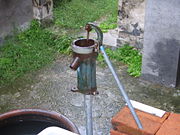

Water supply facilities includes for example water wells cisterns for rainwater harvesting, water supply network, water purification facilities, water tanks, water towers, water pipes including old aqueducts. Atmospheric water generator is in development.
Drinking water is often collected at springs, extracted from artificial borings in the ground, or wells. Building more wells in adequate places is thus a possible way to produce more water, assuming the aquifers can supply an adequate flow. Other water sources are rainwater and river or lake water. This surface water, however, must be purified for human consumption. This may involve removal of undissolved substances, dissolved substances and harmful microbes. Popular methods are filtering with sand which only removes undissolved material, while chlorination and boiling kill harmful microbes. Distillation does all three functions. More advanced techniques exist, such as reverse osmosis. Desalination of abundant ocean or seawater is a more expensive solution used in coastal arid climates.
The distribution of drinking water is done through municipal water systems or as bottled water. Governments in many countries have programs to distribute water to the needy at no charge. Others argue that the market mechanism and free enterprise are best to manage this rare resource and to finance the boring of wells or the construction of dams and reservoirs.
Reducing waste by using drinking water only for human consumption is another option. In some cities such as Hong Kong, sea water is extensively used for flushing toilets citywide in order to conserve fresh water resources.
Polluting water may be the biggest single misuse of water; to the extent that a pollutant limits other uses of the water, it becomes a waste of the resource, regardless of benefits to the polluter. Like other types of pollution, this does not enter standard accounting of market costs, being conceived as externalities for which the market cannot account. Thus other people pay the price of water pollution, while the private firms' profits are not redistributed to the local population victim of this pollution. Pharmaceuticals consumed by humans often end up in the waterways and can have detrimental effects on aquatic life if they bioaccumulate and if they are not biodegradable.
Wastewater facilities are sewers and wastewater treatment plants. Another way to remove pollution from surface runoff water is bioswale.
Industrial applications

Water is used in power generation. Hydroelectricity is electricity obtained from hydropower. Hydroelectric power comes from water driving a water turbine connected to a generator. Hydroelectricity is a low-cost, non-polluting, renewable energy source. The energy is supplied by the sun. Heat from the sun evaporates water, which condenses as rain in higher altitudes, from where it flows down.
Pressurized water is used in water blasting and water jet cutters. Also, very high pressure water guns are used for precise cutting. It works very well, is relatively safe, and is not harmful to the environment. It is also used in the cooling of machinery to prevent over-heating, or prevent saw blades from over-heating.
Water is also used in many industrial processes and machines, such as the steam turbine and heat exchanger, in addition to its use as a chemical solvent. Discharge of untreated water from industrial uses is pollution. Pollution includes discharged solutes ( chemical pollution) and discharged coolant water (thermal pollution). Industry requires pure water for many applications and utilizes a variety of purification techniques both in water supply and discharge.
Food processing
Water plays many critical roles within the field of food science. It is important for a food scientist to understand the roles that water plays within food processing to ensure the success of their products.
Solutes such as salts and sugars found in water affect the physical properties of water. The boiling and freezing points of water is affected by solutes. One mole of sucrose (sugar) raises the boiling point of water by 0.52 °C, and one mole of salt raises the boiling point by 1.04 °C while lowering the freezing point of water in a similar way. Solutes in water also affect water activity which affects many chemical reactions and the growth of microbes in food. Water activity can be described as a ratio of the vapor pressure of water in a solution to the vapor pressure of pure water. Solutes in water lower water activity. This is important to know because most bacterial growth ceases at low levels of water activity. Not only does microbial growth affect the safety of food but also the preservation and shelf life of food.
Water hardness is also a critical factor in food processing. It can dramatically affect the quality of a product as well as playing a role in sanitation. Water hardness is classified based on the amounts of removable calcium carbonate salt it contains per gallon. Water hardness is measured in grains; 0.064 g calcium carbonate is equivalent to one grain of hardness. Water is classified as soft if it contains 1 to 4 grains, medium if it contains 5 to 10 grains and hard if it contains 11 to 20 grains. The hardness of water may be altered or treated by using a chemical ion exchange system. The hardness of water also affects its pH balance which plays a critical role in food processing. For example, hard water prevents successful production of clear beverages. Water hardness also affects sanitation; with increasing hardness, there is a loss of effectiveness for its use as a sanitizer.
Boiling, steaming, and simmering are popular cooking methods that often require immersing food in water or its gaseous state, steam. While cooking water is used for dishwashing too.
Water politics and water crisis
Water politics is politics affected by water and water resources. Because of overpopulation, mass consumption, misuse, and water pollution, the availability of drinking water per capita is inadequate and shrinking as of the year 2006. For this reason, water is a strategic resource in the globe and an important element in many political conflicts. It causes health impacts and damage to biodiversity. The serious worldwide water situation is called water crisis.
UNESCO's World Water Development Report (WWDR, 2003) from its World Water Assessment Program indicates that, in the next 20 years, the quantity of water available to everyone is predicted to decrease by 30%. 40% of the world's inhabitants currently have insufficient fresh water for minimal hygiene. More than 2.2 million people died in 2000 from waterborne diseases (related to the consumption of contaminated water) or drought. In 2004, the UK charity WaterAid reported that a child dies every 15 seconds from easily preventable water-related diseases; often this means lack of sewage disposal; see toilet.
To halve, by 2015, the proportion of people without sustainable access to safe drinking water is one of the Millennium Development Goals.
Fresh water — now more precious than ever in our history for its extensive use in agriculture, high-tech manufacturing, and energy production — is increasingly receiving attention as a resource requiring better water management and sustainable use.
Organizations concerned in water protection include International Water Association (IWA), WaterAid, Water 1st, American Water Resources Association. Water related conventions are United Nations Convention to Combat Desertification (UNCCD), International Convention for the Prevention of Pollution from Ships, United Nations Convention on the Law of the Sea and Ramsar Convention. World Day for Water takes place at March 22 and World Ocean Day at June 8.
Water used in the production of a good or service is virtual water.
Religion, philosophy, and literature
Water is considered a purifier in most religions. Major faiths that incorporate ritual washing ( ablution) include Christianity, Hinduism, Rastafarianism, Islam, Shinto, Taoism, and Judaism. Immersion (or aspersion or affusion) of a person in water is a central sacrament of Christianity (where it is called baptism); it is also a part of the practice of other religions, including Judaism ( mikvah) and Sikhism ( Amrit Sanskar). In addition, a ritual bath in pure water is performed for the dead in many religions including Judaism and Islam. In Islam, the five daily prayers can be done in most cases after completing washing certain parts of the body using clean water ( wudu). In Shinto, water is used in almost all rituals to cleanse a person or an area (e.g., in the ritual of misogi). Water is mentioned in the Bible 442 times in the New International Version and 363 times in the King James Version: 2 Peter 3:5(b) states, "The earth was formed out of water and by water" (NIV).
Some faiths use water especially prepared for religious purposes ( holy water in some Christian denominations, Amrita in Sikhism and Hinduism). Many religions also consider particular sources or bodies of water to be sacred or at least auspicious; examples include Lourdes in Roman Catholicism, the Jordan River (at least symbolically) in some Christian churches, the Zamzam Well in Islam and the River Ganges (among many others) in Hinduism.
Water is often believed to have spiritual powers. In Celtic mythology, Sulis is the local goddess of thermal springs; in Hinduism, the Ganges is also personified as a goddess, while Saraswati have been referred to as goddess in Vedas. Also water is one of the "panch-tatva"s (basic 5 elements, others including fire, earth, space, air). Alternatively, gods can be patrons of particular springs, rivers, or lakes: for example in Greek and Roman mythology, Peneus was a river god, one of the three thousand Oceanids. In Islam, not only does water give life, but every life is itself made of water: "We made from water every living thing".
The Ancient Greek philosopher Empedocles held that water is one of the four classical elements along with fire, earth and air, and was regarded as the ylem, or basic substance of the universe. Water was considered cold and moist. In the theory of the four bodily humors, water was associated with phlegm. Water was also one of the five elements in traditional Chinese philosophy, along with earth, fire, wood, and metal.
Water also plays an important role in literature as a symbol of purification. Examples include the critical importance of a river in As I Lay Dying by William Faulkner and the drowning of Ophelia in Hamlet.
Sherlock Holmes held that "From a drop of water, a logician could infer the possibility of an Atlantic or a Niagara without having seen or heard of one or the other."
| Find more about water on Wikipedia's sister projects: | |
|---|---|
| |
Dictionary definitions |
| |
Textbooks |
| |
Quotations |
| |
Source texts |
| |
Images and media |
| |
News stories |
| |
Learning resources |


